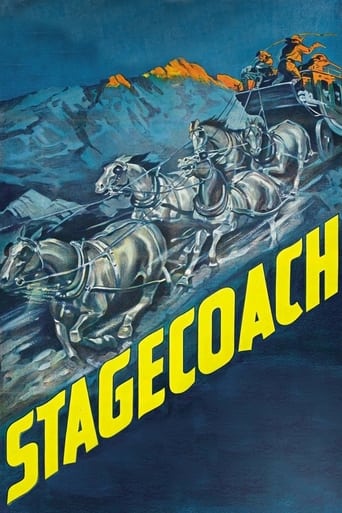

That was an excellent one.
... View MoreIt's a mild crowd pleaser for people who are exhausted by blockbusters.
... View MoreExcellent characters with emotional depth. My wife, daughter and granddaughter all enjoyed it...and me, too! Very good movie! You won't be disappointed.
... View MoreThe joyful confection is coated in a sparkly gloss, bright enough to gleam from the darkest, most cynical corners.
... View MoreSTAGECOACH is a slick, action-focused western from famous director John Ford, best known as the movie that catapulted John Wayne from B-movie success into Hollywood stardom. The plot is simplicity itself and involves a stagecoach riding through Apache territory. Much of it gets by thanks to character interplay between a diverse assortment of different types, among them Wayne's convict hero and John Carradine playing a gambler. After an hour of set-up, the climax lets rip with some well-shot mayhem and a ton of stunts. This isn't my favourite western, but it certainly sets the stage for subsequent entries in the genre.
... View MoreNearing the end of the poll on ICM for the best movies of 1939,I started to check on Amazon UK for DVDs. Hearing about the impact it had on Citizen Kane,and also a fan of their team-up for The Long Voyage Home,I saddled up for the first collaboration between John Ford and The Duke.The plot:In 1880 a group of passengers get on the stagecoach from Tonto, Arizona Territory to Lordsburg, New Mexico Territory. Among the passengers are prostitute Dallas and alcoholic doctor Boone. Before setting off,Buck finds out that his regular guard has gone off to chase after outlaw Henry "The Ringo Kid" escaped jail so he can get revenge for Luke Plummer killing his dad and brother,which leads to Marshal Curly Wilcox taking the role of guard. Going into Apache land, the stagecoach team are soon met by the Apache's,and Ringo.View on the film:Riding into his first "talkie" Western, producer/ director John Ford & cinematographer Bert Glennon display a remarkable eye for using the soundtrack to build upon the images,from the pop of bullets darting round the screen,to the creaking sounds of the stagecoach highlighting how close the group are to danger at every turn. Going to Monument Valley for the first time, Ford looks across a valley of spectacular action,via wide-shots crisply following Yakima Canutt's stunt work, and stylish shots looking out of the window of the rumbling coach.Inspiring Orson Welles (who watched it over 40 times when making his debut) use of ceilings in Citizen Kane,Ford and Glennon brilliantly contrast the great outdoors action with an intimate,claustrophobic atmosphere,of the limited space in the rooms subtly bringing a closeness to Dallas and Ringo,and also squeezing the group into a tight space,where they must work with each other to escape. Loosely based on Boule de Suif by Guy de Maupassant (whose Bel Ami was wonderfully adapted in the same year) and Ernest Haycox's short story The Stage to Lordsburg,the screenplay by Dudley Nichols superbly gives every member of the gang their fair share of attention,which goes from the ill at ease Wilcox and dashing Ringo, to the playful Buck and alluring Dallas. Sending them round the track,Nichols makes each element of the group join into a thrilling team, with the cornering from the Apaches sanding down the dividing differences.The biggest name in the cast when the movie was made, Claire Trevor gives an excellent performance as prostitute (something the Hays Code had "issues" with) Dallas,thanks to Trevor making Dallas strong- willed against any of the guys,but also being well aware of the "outcast" status the job labels her with. Joined by a charming Andy Devine as Buck and a terrific George Bancroft as Wilcox, Da Duke gives a great performance as outlaw Ringo. Pushed around by Ford behind the scenes, Wayne bring out the rough treatment on screen by giving Ringo eyes a burning determination to see the stagecoach complete the journey.
... View MoreNot a lot more need be said about John Ford's classic Western. The setting in Monument Valley is unforgettable, the folk music score is perfect, the script and the ensemble cast is top-notch, and first shot of the Duke, standing in the sand holding a saddle, and spin-cocking his Winchester, is one of the greatest introductions to a character, and ultimately to a legend, in the genre. While best known for its climatic chase and rescue scene, the film is full of brilliant moments such as John Carradine's gambler covering a women's body in the burned out village or Thomas Mitchell's doctor facing down the killer over the shotgun, not ending the final showdown, just making it more even. Even Andy Devine's mild comic relief or Thomas Mitchell's drunk scenes work, unusual as those are the sorts of scenes that rarely pass the test of time. The stunt work by legendary stuntman Yakima Canutt is extraordinary, although some of the techniques used to make horses fall would never be allowed in modern productions. Overall an outstanding film from the Hollywood's legendary year: 1939.
... View MoreLike many of the other films in it's genre, the label of "Western" very accurately describes the film. The cinematography of this film accurately follows the action of the film and the vision of the director as to where the audience should be looking and when. This film uses sound to help connect the viewers to the action happening in the film and furthermore made the film that much more realistic. The scenery for this film has to be the strongest element. It's realisticness is such that it makes viewers believe that this was actually happening which leads to further enjoyment by the audience. The intensity of this movie also left the audience on the edge of their seats which tends to leave a lasting effect on them. This genre is not for everyone so if this doesn't sound appealing to you, you probably shouldn't watch it!
... View More